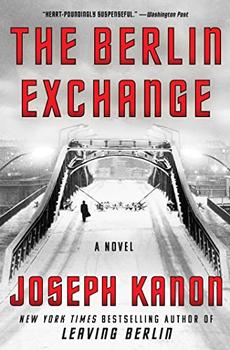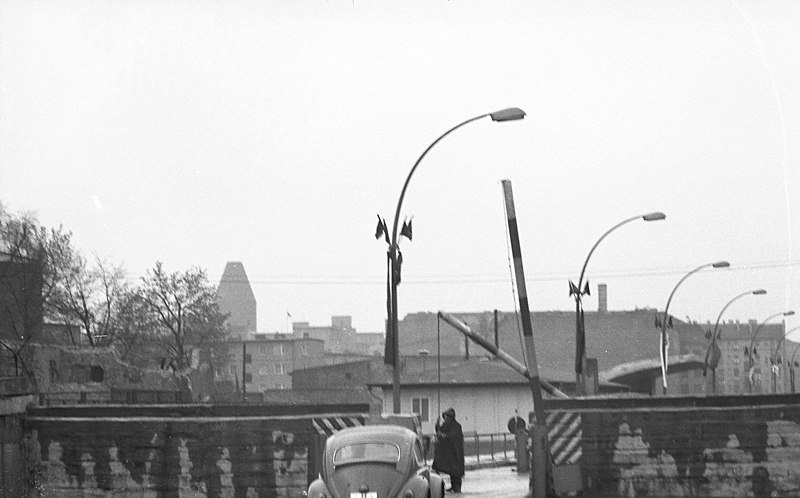Summary | Excerpt | Reading Guide | Reviews | Beyond the Book | Read-Alikes | Genres & Themes | Author Bio

A Novel
by Joseph KanonThis article relates to The Berlin Exchange
 Wherever borders and barriers exist, resistance and the desire to escape will also be found. In The Berlin Exchange, Joseph Kanon's Cold War espionage thriller, the Berlin Wall looms as a formidable barricade. The book is set in 1963; only months earlier, the miraculous story of Tunnel 29 — so called because of the number of people it enabled to escape — played out in real life.
Wherever borders and barriers exist, resistance and the desire to escape will also be found. In The Berlin Exchange, Joseph Kanon's Cold War espionage thriller, the Berlin Wall looms as a formidable barricade. The book is set in 1963; only months earlier, the miraculous story of Tunnel 29 — so called because of the number of people it enabled to escape — played out in real life.
For those hoping to escape the brutality of East Germany (the German Democratic Republic/GDR) for the relative freedoms of the West, the wall was an obstruction few managed to conquer. For the duration of the Berlin Wall's presence from 1961 to 1989, over 100,000 people attempted to escape the GDR but only around 5,000 crossed the border successfully. The vast majority of potential escapees were captured and detained as political prisoners, while at least 140 died while attempting to flee.
At the end of World War II in 1945, control of Germany was split between the four victors. What would become known as West Germany fell under the purview of France, Britain and the United States; while the Soviet Union took charge of East Germany except for the capital city of Berlin (located well inside East Germany), which was split between the four nations. By the mid-50s, both East and West Germany had transitioned to civilian leadership but the four nations retained a strong interest in the region throughout the Cold War, and split control of Berlin right up to Reunification, with French, British and US sectors on the West side and the Soviet sector on the East.
For 16 years following the end of the war, Berliners had been able to pass back and forth between the East and West sides of the city relatively easily, and many did so on a daily basis for work. That changed on the morning of August 13, 1961, when Berliners woke up to find that East German soldiers had spent the night stretching barbed wire across the city, so as to prevent an exodus of East Germans defecting to the West in search of a better life. This was the birth of the 155 kilometer (96 mile) barrier that would divide Berlin for the next 28 years, tearing apart families and friends and brutally curtailing freedoms.
Escape attempts commenced almost immediately following the erection of the wall, with East Berliners willing to go to extreme measures: Some would sneak into houses close to the wall and jump from an upstairs window over to the other side; others would attempt swimming across the River Spree or crossing it in bathtubs; false documents and secret compartments in cars were common strategies; and, of course, there was tunneling.
That same year, a 22-year-old civil engineering student called Joachim Rudolph was living in West Berlin, although he hailed from a town in the GDR, having undertaken the risky journey from East to West. One night in October, there was a knock on his door; the visitors were two Italian engineering students known to Joachim — they wanted to dig a tunnel in order to rescue friends from the East, and needed his help. Joachim had already made the daredevil move of escaping the GDR, yet rose to the challenge of making a return journey.
To say that Joachim's undertaking was a risk is an understatement. The penalties for those caught were chilling; the Stasi were notorious for their psychological torture methods. The Stasi prison, Hohenschönhausen, was feared for its grim conditions and brutal treatment of defectors.
Nevertheless, Joachim and his friends set about finding a location to start digging. They settled on a factory that made cocktail straws. They tried to gain access on the pretext that they were jazz musicians and needed a place to rehearse; the owner guessed their real intentions but was sympathetic to their cause. With their engineering skills being put to work, the group started digging in earnest, reaching a depth of 1.3 meters over a few nights before tunneling horizontally. Over the next 38 days, the students dug away for eight hours a day. The stretch of tunnel known as the "death strip" posed a particular risk. Above them, armed guards were tasked with listening for defectors. If they were heard, the guards would dig a hole and either fire a gun or throw in dynamite. Joachim and the other students could actually hear the guards talking, so close were they to their destination. But only 50 meters away from the basement that was the terminus of the tunnel, disaster struck: a leak. The diggers had no choice but to abandon the mission and wait for the leak to dry out.
Meanwhile, NBC News had provided funding for Joachim and his team, as the TV producer wanted to make a documentary charting escape attempts. The money provided vital tools for the diggers, and every stage of the process was filmed.
In July 1962, Joachim was made aware of another tunnel, now abandoned. The students set their sights on making this new tunnel the escape route. The plan was scuppered when one of their number, a hairdresser called Siegfried Uhse who volunteered to act as a messenger to the East, turned out to be a Stasi informant. This was a close shave for the diggers, who narrowly escaped capture.
Undeterred, Joachim resumed his dangerous quest. Using a new messenger, 21-year-old West Berliner Ellen Schau (who later wrote a book about her role), plans were made for a September 14 rescue mission that would prove to be successful. Filmed by the NBC crew, the first escapee to come through the tunnel was a woman called Eveline Schmidt, who emerged with her young daughter, Annett. For Eveline, her story was to have an unexpected coda; little did she know that 10 years later she would marry the architect of her rescue: Joachim Rudolph.
While Tunnel 29 is a story from a period that is now over, it still resonates today — for it is essentially a story of escaping tyranny, and of refugees. Joachim's experience has been detailed thoroughly in Helena Merriman's book and podcast series Tunnel 29, while other stories from behind the wall are recounted with empathy and journalistic integrity by Anna Funder in the award-winning Stasiland.
In America, the White House was reportedly reluctant to let the NBC documentary (below) air. At risk was the diplomatic relationship between the Soviets and the USA. However, air it did, and President Kennedy allegedly shed a tear or two.
Berlin Wall at Potsdamer Platz, 1962. Photograph by Manta22 (CC BY-SA 4.0)
Filed under People, Eras & Events
![]() This "beyond the book article" relates to The Berlin Exchange. It originally ran in March 2022 and has been updated for the
March 2023 paperback edition.
Go to magazine.
This "beyond the book article" relates to The Berlin Exchange. It originally ran in March 2022 and has been updated for the
March 2023 paperback edition.
Go to magazine.
Your guide toexceptional books
BookBrowse seeks out and recommends the best in contemporary fiction and nonfiction—books that not only engage and entertain but also deepen our understanding of ourselves and the world around us.